Check out this beautiful video shot by two Irish fimmakers who found themselves paddling in the right place at the right time. This natural phenomemon of a mass starling gathering will blow you away.
Learn more at islandsandrivers.com.
Check out this beautiful video shot by two Irish fimmakers who found themselves paddling in the right place at the right time. This natural phenomemon of a mass starling gathering will blow you away.
Learn more at islandsandrivers.com.
“The Tlapacoyan municipality in the state of Veracruz, Mexico has some of the most beautiful and wild rapids in the world. Naturally, this makes them attractive to whitewater kayakers. Every year more and more of them travel to the area to test their abilities in this natural water park. We ride along with Jordan Poffenberger, Dylan McKinney, Ryan McAvoy, Dane Jackson, Nick Troutman, Eric Jackson, Nathan Sass, Van Nail, and Robert Waldron as they thread the needles of some unbelievably narrow chutes and huck themselves off of a few waterfalls. These guys are masters of both the helmet cam and the slo-mo shot. You can almost feel your paddle scraping against the riverside boulders that menace every turn. Whatever you do, don’t miss the waterfall sequence that starts at 3:10, it will make your day. Kayaking Scary Rapids Isn’t Supposed to Be This Fun | Everlasting Flow, Ep. 3”
From EpicTV.
This leisurely sightseeing trip meanders its way through lush mangrove and cypress forests within Florida Everglades National Park’s 1.5 million acres. The winter months are best for paddlers as the temperatures are cooler and the mosquitoes fewer…
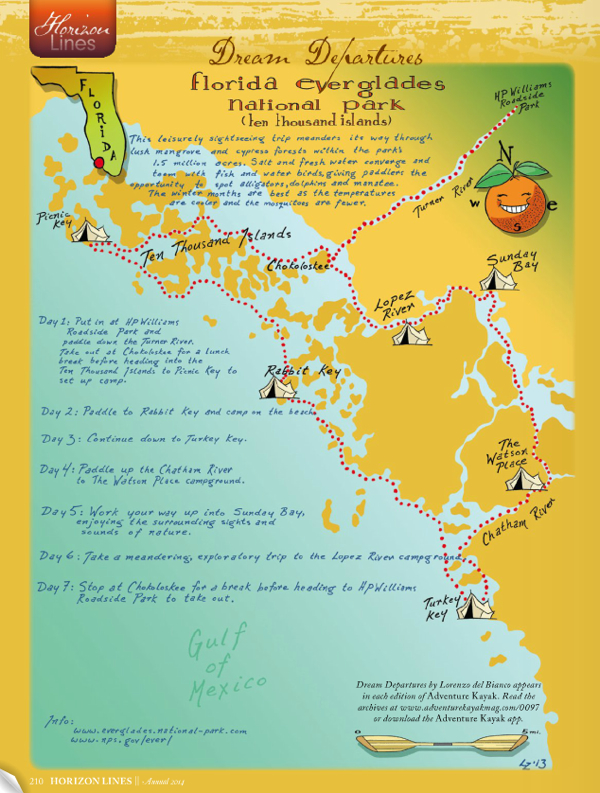
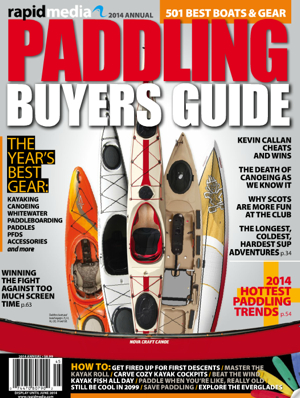
This Dream Departure is excerpted from the Rapid Media 2014 Buyer’s Guide. Download our free iPad/iPhone/iPod Touch App or Android App or read it on your desktop here.
Today at Outdoor Retailer Winter Market, Bill Kueper, vice president of Wenonah Canoe, and Todd Bradley, president of C4 Waterman, announced the merger of C4 Waterman into Wenonah’s existing worldwide distribution network.
The merger will improve global access to C4 Waterman products, leveraging the strength of Wenonah’s established and growing distribution network. Additional synergy is anticipated from Wenonah’s extensive experience and brand legacy in global supply chain management.
“The addition of C4 Waterman SUP, safety, rescue accessories and apparel products to Wenonah’s brand stable makes Wenonah a one-stop-shop for SUP, kayak and canoeing,” said Kueper.
C4 Waterman, a Hawaii-based adventure sports company making tools to support the waterman lifestyle, ensures their company’s position as a premiere brand in the global action sports industry by aligning with Wenonah.
Wenonah’s founder and owner, Mike Cichanowski, believed in C4 Waterman from the beginning and helped launch the brand at Outdoor Retailer Summer Market in 2007.
This introduction to the outdoor industry brought some of Hawaii’s most legendary watermen and a refined, premium line of standup paddleboards and paddles. Today, C4 is recognized worldwide as a pioneer of SUP surfing and racing, as it continues to break new ground with inflatable SUPs and innovative tools for rivers and oceans and water rescue equipment.
While inventive product design has kept C4 ahead of the pack, it is the team’s dedication and commitment to sharing the lifestyle of the waterman, through its key ambassadors in River, Ocean and Safety that make them leaders in the industry.
Brian Keaulana, co-founder of C4 Waterman, added, “As we’ve always said, ‘waterman’ is more than a word, it’s a lifestyle. No single piece of equipment defines a waterman. Partnering with Wenonah Canoe will allow us to become the company we have always envisioned: a lifestyle brand providing the best quality products to make the waterman’s time on the water as productive and enjoyable as possible. We look forward to exploring the many opportunities that lie ahead.”
“This will be a very exciting phase for C4 Waterman, with the expansion of the brand well beyond the standup paddle equipment that we are best known for, our portfolio of new innovations is now ready to share with the world,” added Todd Bradley, co-founder of C4 Waterman.
Learn more at www.Wenonah.com and www.C4Waterman.com.
Sea Kayak with Gordon Brown: Volume 3, a new DVD from Scottish sea kayak coach Gordon Brown, delves into three critical—yet often overlooked—elements of kayak safety and skills: navigation, first aid and dealing with emergency situations.
Following up on the success of Sea Kayak with Gordon Brown, the award-winning debut effort of Brown and producer Simon Willis, the pair released a follow-up film in 2011 that focused on teaching rescue techniques. With Volume 3, Brown and Willis explore some engrossing new territory for a kayak instructional DVD.
We asked the team about the challenges of producing a film that features, among other things, behind-the-scenes footage of actual Coast Guard air and sea rescues in progress.
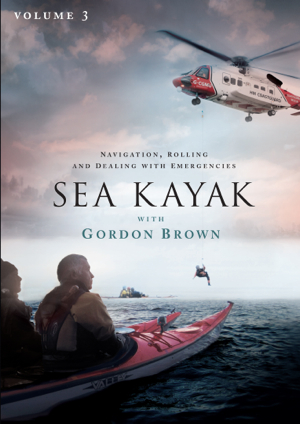
There are a few hairy moments in this film—the parachute flare incident comes to mind… what were the biggest challenges of producing the rescues portion of the DVD?
SW: Daring to believe we could make such an ambitious film that required the loan of a Coast Guard rescue helicopter and two RNLI lifeboats. How do you ask a government authority, “Can I borrow a chopper please?” No one had attempted an instructional film like this before, so I couldn’t tell them “it’ll look like this.” Nor could I show them a script, because everything in the film came later after talking to the experts and learning how they conduct different rescues in different situations and conditions. Where there were no official protocols, Gordon worked with the different crews to develop the best way for them to deal with sea paddlers. They literally were making it up as they went along – I just filmed it.
Once we started the main block of filming, my biggest challenge was the weather. It was too good! We decided to film off Scotland’s Outer Hebrides in February because we wanted challenging conditions, but a high pressure weather system settled overhead for a whole week. The light was fantastic, but zero wind meant our helicopter could only carry out winch rescues in genuine emergencies, not in training situations and definitely not when filming. Fortunately the weather returned to normal within two weeks and we returned to get the shots we needed, albeit with a different winch-man and winch operator. If you look carefully, the crew inside the helicopter appears to change clothes part way through the sequence.
GB: When we decided that we wanted to do some live flare firing from the kayak, it was pretty easy to get the permissions necessary from the Coast Guard, provided we used a white parachute flare. The parachute flare or rocket was quite a surprise. I have let off quite a few of these over the years on land in a practice situation, but the thought now of letting one off whilst in a kayak makes me shiver. I can still remember the feeling of the ‘thump’ on the heel of my hand as it went off. I’ve kept the empty tube as a reminder, too.
What was it like to actually put yourself in the position of needing a Coast Guard rescue?
SW: At no stage did any of our kayakers genuinely need a rescue. We were prepared for the professionals to be called away to a genuine emergency at any moment. They wouldn’t wait for us! When Gordon and Andy appear to be floating alone without paddles, both have four-section Werner paddles stowed in their hatches and there are two other paddlers filming them with tow lines and a back-up VHF. Everyone involved was an experienced paddler who could take care of him or herself, but we took no chances.
GB: I have yet to put myself in the position of needing the professionals to help me. I am now quite confident that by working with these fantastic people, I will be able to help myself if, or when, it does happen. I hope that people who watch the DVD will get a similar amount of useful information.
Did you learn any new skills or tactics—or debunk any common misconceptions—while producing this film?
GB: The direction finding capabilities of both helicopter and lifeboat makes it absolutely necessary to carry a VHF radio. The fact that a pinpoint red flare is more easily seen [than an orange smoke flare] was an eye opener. I also learned that it is almost impossible, when you are below a rescue chopper, not to look up in awe. The noise, the spray the precision of the crew all make you just want to watch and enjoy.
SW: As a sea kayaker myself, I’ve changed what kit I carry as a result of working with the professionals. The film’s aim is to share the insight into how the emergency teams work, allowing you to decide what to carry for the kayaking you do.
I also learnt I can lean right out of a helicopter with a camera on my shoulder and not be terrified! Don’t laugh – I went two days early to the Outer Hebrides so I could practice filming with fresh air below my feet because I expected to be terrified. However, once my eye was to the viewfinder I was seeing everything on TV and was relaxed.
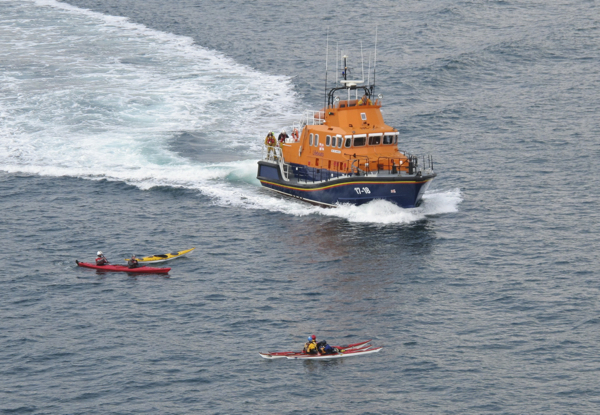
Sea Kayak with Gordon Brown, Volume 1 and 2 use a unique platform of an instructional journey to teach the skills, whether they be kayak handling or navigation. Tell me about how you developed this format. Why does it work well for teaching sea kayak skills?
SW: Usually Gordon handles the kayaking and I handle the filming, but occasionally there is an inspired cross-over of ideas. Our format of combining a journey with coaching was entirely Gordon’s idea and one he devised right at the start. Gordon coaches sea kayaking within the context of a journey so he felt the films ought to operate in the same way. It was up to me to make it all work.
From the filmmaking viewpoint it delivers a secondary benefit. Some instructional DVDs are so jammed full of non-stop coaching they become too intense and overpowering to watch. There’s only so much information your brain can absorb before the additional facts start running out of your ears. Breaking up the instruction with a spectacular journey not only is a feast for the eyes, it gives the viewers time to digest what they’ve learnt and prepare themselves for the next lesson. Actually, it works in a similar way to one of Gordon’s real-life coaching sessions.
Against the advice of our executive producer, we tore ourselves away from this format for Volume 3. There were several reasons, the main one being that the topics we wanted to coach were too diverse to fit around one film. That said, the Emergency Situations, Sea Kayak Navigation and First Aid Kits films [in Volume 3] are proper, stand-alone films, each with a well thought out structure.
Who do you think will enjoy this DVD?
SW: Emergency Situations is the sort of show I’d have made when I worked for the BBC, so I think it will appeal to anyone, whether they kayak or not. Advanced paddlers will pick up lots of coaching tips from the way Franco Ferrero coaches navigation, Rowland Woollven coaches first aid and Gordon coaches… well, everything.
GB: I think that most people who enjoy a bit of excitement will enjoy the main film, more so if they are ever likely to need the help of the rescue services. The others are more suited to kayakers, but with the exception of the Rolling Clinic all work with anyone who is in the outdoors.
Any plans for a Volume 4?
SW: At this stage in each production I say, “Never again.” Yet two years later we launch a new DVD. So anything I say now will probably be wrong.
GB: If we were to make [another film], I think we would have to change our approach. I don’t coach the same thing twice the same way. Simon works out the tech stuff to allow us to film what hasn’t been done before and I guess that it’s down to me to come up with another hair-brained, half-cooked idea that is impossible to do, worse than impossible to film and ridiculous to make work as a coaching film, then he’ll work his magic.
To learn more, access free downloads or purchase a film, visit www.seakayakwithgordonbrown.com.
This article appeared in Paddling Magazine, December 2013. Download our free iPad/iPhone/iPod Touch App or Android App or read it here.
Windy days on the water can be exhilarating or frightening, depending upon how you face the challenges they present. By keeping in mind these tips for safe passage, you can cut out the frustration and paddle your canoe on to more sheltered waters.
Here’s our best advice for canoeing in the wind, to keep you safe and frustration-free.
Your canoe is a weathervane in wind. Avoid pinwheeling by weighing the bow down one to two inches when traveling upwind and weighing down the stern in a tail wind. Don’t go overboard with this method; an end that rides too deep may take on waves.
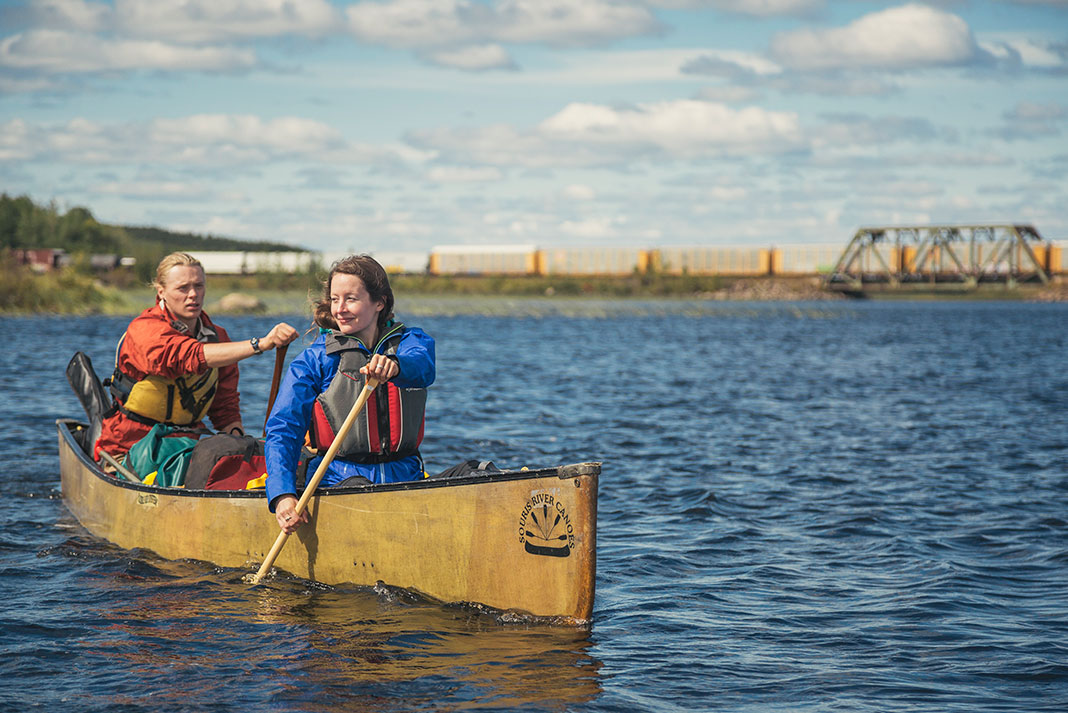
The most common advice canoeists receive for travel on windy days is to quarter waves. This means paddling into big waves at a 30- to 45-degree angle, which is effective because it allows the craft to fit between wave crests. While this technique promises a drier ride and a craft that rises faster to meet oncoming waves, it’s not for everyone.
A canoe quartering waves is constantly on the verge of broaching to the wind. One mistake and it’s a potential capsize. For this reason, quartering waves is for experienced paddlers only. Beginners are safer to move closer to the center of the boat, thereby lightening the bow and stern, and paddle head-on into the wind.
How your canoe handles waves is generally determined by wave length, rather than wave size. If you have an 18-foot-long canoe and the waves are spaced 14 feet apart, you’re in for a wet ride. Facing those waves head-on could mean swamping.
If head-on running results in a dangerously wet ride and you can’t hold a quartering course, try running broadside to the waves, paddling in the trough between them. Your canoe will fit between the waves and bob like a cork, up one face and down another.
If you’re looking to paddle to a distant point but are confronted with a side wind, try tacking. If you paddle directly toward your destination, a strong side wind will blow your canoe off course and result in having to paddle back upwind. The solution is to aim 45 degrees upwind of your target and paddle hard—the wind will take you straight to your mark.
Despite what you’ve heard, it’s sometimes okay for canoeists to paddle on the same side. Paddling on the same side—in unison—is the right choice when you can’t hold the course in a quartering or side wind. Paddle on the downwind side of your boat.
Take advantage of quiet-water wind eddies that form in bays and around points. Conserve your strength by darting quickly from one protected spot to another, then resting briefly before powering on to the next calm place.
Make all open water crossings short and fast by crossing at the narrowest point when possible. Plan on paddling one mile an hour in a heavy headwind and five miles an hour in a tail wind. I’m suspicious of any crossing more than half a mile long with a headwind or five miles long with a stern wind, and will consider changing or delaying my route to avoid it.
Wind can create some tricky conditions, but these tactics will help. | Feature photo: Image Ontario
This whitewater open boat technique article originally appeared in Rapid magazine.
Over the years I’ve picked up some lesser-known canoeing techniques that have allowed me to do awesome things in shorter canoes like the L’Edge. I discovered most of these tricks a decade ago when I was paddling a Spanish Fly. The smaller the canoe you paddle, the more important it becomes to leverage your upper body weight to create momentum. Here are some techniques I use that will help you on everything from your local class III river to highly technical class V runs.
If you’re running continuous creeks in a canoe, your boat is going to fill up with water, making it tough to catch eddies. One trick I use is to aggressively throw my upper body forward to help punch strong eddylines. It makes a huge difference if you have a canoe full of water and are worried about getting rejected and slipping into the next rapid backwards. The key is to throw your weight forward as you approach the eddy from a perpendicular angle. Once your body weight is through the eddyline, your stern will follow.
Another way you can use your upper body weight is by leaning forward on big, fast, bouncy slides—a move David “Psycho” Simpson taught me 12 years ago, the first time I ran Oceana on the Tallulah Gorge. Your natural instinct is to lean back on a slide. But if you hit a rut and take a funny bounce, your canoe can easily get off line and send you in a direction you don’t want to go. Shift your weight forward on fast bouncy slides and your canoe will track better and take you where you want to go.
Upper body momentum can also keep you dry in big wave trains. Lean forward going into a wave and then aggressively throw your upper body back to raise your bow. This helps keep your boat dry on waves where most boats take on water. That leaves you in a better position for the rest of the rapid. Less time spent stopping to dump out water means more time for playing.
When your canoe is completely full of water, you can also use upper body weight and momentum to punch large holes. Generally, I try to avoid large holes altogether. However, when your boat is full of water, skirting a hole may not be an option. If you’re full, throw your upper body weight forward aggressively as you enter a large unavoidable hole. If you commit with your weight forward and you’re carrying good downstream momentum, you will punch the hole and come through right side up more times than not.
Upper body weight also comes into play running waterfalls. I like to go off waterfalls slightly faster than the current. I spot my landing visually, plant my paddle and take a quarter-strength boof stroke, count to one and then throw my upper body forward and tuck. If I find myself flipping to my onside, I tighten my core, arch my back and use my upper body lean to get the boat back under me.
For more ways to boost your whitewater game, click here.
Dooley Tombras is a Tennessee native known for shattering perceptions of what can be accomplished in an open boat.
This article originally appeared in Rapid, Fall 2012. Download our free iPad/iPhone/iPod Touch App or Android App or read it here.
“There are a couple of reasons that the Stikine River in British Columbia is often considered the Everest of river kayaking. It’s in the middle of nowhere, it passes through numerous sheer gorges, it requires extended portages over huge boulders and, oh yes, the rapids are somewhat intimidating. None of this discourages the Catalunyan brothers, Gerd and Aniol Serrasolses. Along with a strong supporting cast, they confront the meanest that the Stikine can throw at them and pop up smiling — no mean feat when the whitewater is this nasty. The hole that they skirt at 4:40 looks like something out of a Greek myth. Stick around till the end to get the helmet-cam view of some of the most intense runs. Kayaking Doesn’t Get More Difficult and Remote Than This | Kayak the World with SBP, Ep. 6”
From Epic TV.
Ray Chaplin is an ex-IT professional who recently completed the first descent of South Africa’s Orange River by riverboard with an environmental message. Paul Everitt of Going Solo Adventures caught up with Ray to learn more about his journey.
What riverboard were you using for the Orange River Project and can you please explain what a riverboard is?
Ray – The Anvil from Fluid Kayaks, as it is made of the tried and tested plastics that they’ve been using in their kayaks. It was also designed and developed here in South Africa. Riverboarding is a ‘facelevel’ sport, whereby you lie down on the board and hold onto two handles up front with your legs off the back for propulsion and steering. It is much the same as bodyboarding, just that we do it in rivers alongside the whitewater kayakers and rafters.
Why did you choose to use a riverboard over the more conventional mode of water transport like a kayak, canoe or even a raft?
Ray – I’ve cycled and walked across South Africa and was looking for something to do in the water. Wanting to go alone, I needed to keep my personal safety in mind when choosing a discipline. With riverboarding, the learning curve is quick and you can enjoy some big water in relative safety quite soon after starting, with no worries about rolling or getting stuck in your boat (or losing your boat if you eject). An added bonus is that riverboarding is unusual in South Africa with only a handful of us doing it, which helps when trying to attract attention to an environmental message.
What dangers did you encounter along the way and was there ever the chance of something taking a bite out of you?
Ray – Thankfully there are no crocodiles, hippos, piranhas or similar such creatures lurking—the otters and large cat fish have been known to cause a few problems, but I was lucky to avoid any contact. I had some close encounters with scorpions, and saw a few snakes. Other than that, I just had to watch out for debris in the river, broken down bridges that were just beneath the surface caused some issues with steel rods ready to pierce my body if I happened to choose the wrong line.
What distance were you capable of covering over a good day and was there ever any reoccurring obstacle that slowed your progress?
Ray – Headwinds were my biggest killer and sometimes dropped my daily distance to 10 kilometers, but generally anywhere between 15 and 22 kilometers a day. I managed to push out some 25- to 28-kilometer days at the end.
Most expeditions run the gamut of emotions—fear, excitement, anxiety, joy, thoughts of lunacy—was there any point during the expedition that you had second thoughts about continuing?
Ray – I suffered a serious back injury just after the halfway mark when I fell and broke some vertebra and ribs in my back. While I knew then I wouldn’t be able to continue immediately, it was when I returned to the river (just 8 weeks later, not 6 months as the doc suggested) that I was full of doubt. My body was sore, the water was incredibly bad quality and I was regularly ill. But after some thinking and a nice campfire one night I realized I was there for a reason and nobody had asked or forced me to go, so it was time to suck it up and push forth.
This is an excerpt from adventurer Paul Everitt’s Q&A with Ray Chaplin. To read the full interview, click here.
To read Rapid’s full report on Chaplin’s journey, click here.
Perfect for couples, Big Agnes’ Cabin Creek eliminates the gap between hoods, as well as stuck zippers when zipping two bags together. Rated to 15 degrees Fahrenheit, this doublewide, synthetic bag stuffs down to 10 by 13 inches. Designed to be used as part of a Big Agnes sleep system.
$269.95 | www.bigagnes.com